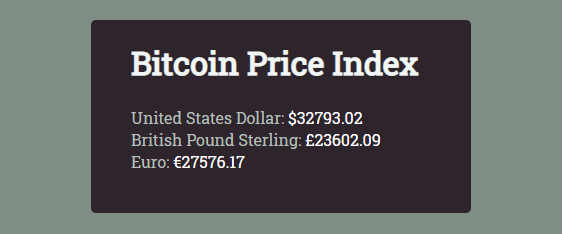在vue.js中如何使用axios访问api?如何使用axios访问api经验分享!
相信很多人都有听过api连接,那么今天我们就来说说有关于“在vue.js中如何使用axios访问api?”这个问题吧!下面小编整理的相关资料希望对大家有所帮助!
1、在很多时候在我们要构建应用时都需要访问一个 API 并展示其数据。但是对于做这件事的方法有好几种,下面我们来说下最流行的一种吧!使用基于 promise 的 HTTP 客户端 axios 。然而在我们这次分享中,我们会使用 CoinDesk API 来完成展示比特币价格且每分钟更新的工作。
2、首先,我们要通过 npm/Yarn 或一个 CDN 链接安装 axios。
我们有很多种方式可以从 API 请求信息,但是最好首先确认这些数据看起来长什么样,以便进一步确定如何展示它。从而我们会调用一次这个 API 并输出结果,以便我们能够看清楚它。就像 CoinDesk 的 API 文档中所说的,请求会发送到 https://api.coindesk.com/v1/bpi/currentprice.json。所以,我们首先创建一个 data 里的 property 以最终放置信息,然后将会在 mounted 生命周期钩子中获取数据并赋值过去代码如下:
new Vue({
el: '#app',
data () {
return {
info: null
}
},
mounted () {
axios
.get('https://api.coindesk.com/v1/bpi/currentprice.json')
.then(response => (this.info = response))
}
})
<div id="app">
{{ info }}
</div>
当我们执行完成之后会得到下面这样:
{ "data": { "time": { "updated": "Jun 22, 2021 06:59:00 UTC", "updatedISO": "2021-06-22T06:59:00+00:00", "updateduk": "Jun 22, 2021 at 07:59 BST" }, "disclaimer": "This data was produced from the CoinDesk Bitcoin Price Index (USD). Non-USD currency data converted using hourly conversion rate from openexchangerates.org", "chartName": "Bitcoin", "bpi": { "USD": { "code": "USD", "symbol": "$", "rate": "32,793.0171", "description": "United States Dollar", "rate_float": 32793.0171 }, "GBP": { "code": "GBP", "symbol": "£", "rate": "23,602.0854", "description": "British Pound Sterling", "rate_float": 23602.0854 }, "EUR": { "code": "EUR", "symbol": "€", "rate": "27,576.1727", "description": "Euro", "rate_float": 27576.1727 } } }, "status": 200, "statusText": "", "headers": { "cache-control": "max-age=15", "content-length": "679", "content-type": "application/javascript", "expires": "Tue, 22 Jun 2021 07:01:07 UTC" }, "config": { "transformRequest": {}, "transformResponse": {}, "timeout": 0, "xsrfCookieName": "XSRF-TOKEN", "xsrfHeaderName": "X-XSRF-TOKEN", "maxContentLength": -1, "headers": { "Accept": "application/json, text/plain, */*" }, "method": "get", "url": "https://api.coindesk.com/v1/bpi/currentprice.json" }, "request": {} }这样子我们已经得到的部分数据,但是看起来却很乱,那么接下来我们需要为它添加一些处理,以防出现异常情况或请求超时。
3、api数据展示
在正擦的情况下,我们需要的信息已经包含在了响应中,所以只需要遍历我们保存下来的内容就能正确地获取。在下面这个例子中,我们就可以看到我们需要的价格信息在 response.data.bpi 中。如果我们换用这个,则输出是下面这样的:
js代码部分如下:
axios
.get('https://api.coindesk.com/v1/bpi/currentprice.json')
.then(response => (this.info = response.data.bpi))乱码部分如下:
{ "USD": { "code": "USD", "symbol": "$", "rate": "32,793.0171", "description": "United States Dollar", "rate_float": 32793.0171 }, "GBP": { "code": "GBP", "symbol": "£", "rate": "23,602.0854", "description": "British Pound Sterling", "rate_float": 23602.0854 }, "EUR": { "code": "EUR", "symbol": "€", "rate": "27,576.1727", "description": "Euro", "rate_float": 27576.1727 } }通过上面的两部分乱码对比,我们发现第二次的乱码会比第一次好了许多,这也让展示的工作变得容易了很多,所以我们可以更新 HTML 以从获取的数据中仅仅展示真正需要的信息。那么接下来我们会创建一个过滤器来确保小数部分的合理展示。代码如下:
<div id="app">
<h1>Bitcoin Price Index</h1>
<div
v-for="currency in info"
class="currency"
>
{{ currency.description }}:
<span class="lighten">
<span v-html="currency.symbol"></span>{{ currency.rate_float | currencydecimal }}
</span>
</div>
</div>js代码部分:
filters: {
currencydecimal (value) {
return value.toFixed(2)
}
},结果如下:

4、错误处理
在很多的时候我们并没有从API中获取到自己想要的数据,这是有很多因素引起的,一下是有关于axios调用失败的一些原因(但是不仅限于这些):
- API不工作;
- 请求发错;
- API没有按照我们的预期格式返回信息。
还有当我们在发送请求的时候,我们应该检查一下上面提到的这些情况,并且在所有情况下都返回相应的信息从而方便处理这些问题,一般我们在axios中会使用catch来做事件,代码如下:
axios
.get('https://api.coindesk.com/v1/bpi/currentprice.json')
.then(response => (this.info = response.data.bpi))
.catch(error => console.log(error))我们通过这样的设置我们就可以知道请求API的过程中是否有地方出错了,那么如果数据长时间生成不出来或者API不工作会是怎么样的呢?下面我们就来构建在无法获取数据时通知用户的加载效果,代码如下:
new Vue({
el: '#app',
data () {
return {
info: null,
loading: true,
errored: false
}
},
filters: {
currencydecimal (value) {
return value.toFixed(2)
}
},
mounted () {
axios
.get('https://api.coindesk.com/v1/bpi/currentprice.json')
.then(response => {
this.info = response.data.bpi
})
.catch(error => {
console.log(error)
this.errored = true
})
.finally(() => this.loading = false)
}
})Html部分代码:
<div id="app">
<h1>Bitcoin Price Index</h1>
<section v-if="errored">
<p>We're sorry, we're not able to retrieve this information at the moment, please try back later</p>
</section>
<section v-else>
<div v-if="loading">Loading...</div>
<div
v-else
v-for="currency in info"
class="currency"
>
{{ currency.description }}:
<span class="lighten">
<span v-html="currency.symbol"></span>{{ currency.rate_float | currencydecimal }}
</span>
</div>
</section>
</div>我们可以在例子中点击 Rerun 按钮以便看到我们从 API 获取数据时的加载状态。
5、替代方案
Fetch API
对于Fetch API 它是一个用于此类请求的强大的原生 API。它的好处就是你不需要在使用它的时候额外加载一个外部资源。但是的话目前它还没有被浏览器完全支持,所以我们仍然需要一个 polyfill。
总结:
以上就是有关于“在vue.js中如何使用axios访问api?”这个问题的相关内容,当然如果你有其他的看法也可以提出来和大家一起分享!更多有关于vue.js的相关知识内容我们都可以在W3CSCHOOL中进行学习和了解。
相关资料链接:
CoinDesk API :https://www.coindesk.com/coindesk-api
vue过滤器:https://cn.vuejs.org/v2/api/#Vue-filter